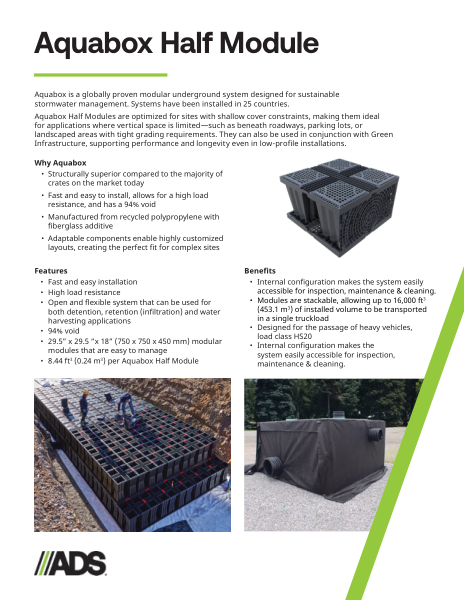Aquabox Half Module Product Sheet
Filename:
Aquabox Half Module Product Sheet.pdf

This document is the Aquabox Half Module Product Sheet. Features, benefits and specifications discussed with photographs, table and figures.
Aquabox is a globally proven modular underground system designed for sustainable stormwater management. Systems have been installed in 25 countries. Aquabox Half Modules are optimized for sites with shallow cover constraints, making them ideal for applications where vertical space is limited—such as beneath roadways, parking lots, or landscaped areas with tight grading requirements. They can also be used in conjunction with Green Infrastructure, supporting performance and longevity even in low-profile installations.
Aquabox is structurally superior compared to the majority of crates on the market today. Fast and easy to install, allows for a high load resistance, and has a 94% void. Manufactured from recycled polypropylene with glass additive. Adaptable components enable highly customized layouts, creating the perfect fit for complex sites.
Features include fast and easy installation, high load resistance, open and flexible system that can be used for both detention, retention (infiltration) and water harvesting applications, 94% void, manufactured from recycled polypropylene with fiberglass additive and adaptable components enable highly customized layouts, creating the perfect fit for complex sites.
Benefits are internal configuration makes the system easily accessible for inspection, maintenance & cleaning. Modules are stackable, allowing 453.1m3 (16,000 ft3) of installed volume to be transported in a single truckload. Designed for the passage of heavy vehicles, load class HS20 and internal configuration makes the system easily accessible for inspection, maintenance & cleaning.
Photographs of the Aquabox half modules with specification table for dimension, weight, material, net volume, void, pallet size and number of pieces per pallet provided. Cross section and figures explained.
